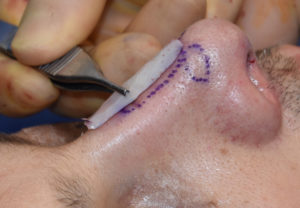Augmentation of the nose can be successfully done by a variety of materials. While each autologous and alloplastic material has their own advantages and disadvantages, one’s own cartilage will always have the superior biologic edge. While cartilage is from one’s own body and is well accepted like all other autologous grafts, it has the unique property of being relatively inert. A cartilage graft put in today will look the same when seen years later. (which is very much unlike most other autologous grafts)
The need for cartilage grafts in rhinoplasty is greatest when dorsal augmentation is needed. Significant dorsal augmentation requires substantial cartilage graft material. Of the three sources of cartilage graft harvest, only the septum offers an assured straightness which is of paramount importance in dorsal augmentation rhinoplasty.

But once the septum has been harvested it is no longer of any value for dorsal augmentation. When really significant amounts of dorsal augmentation are need, such as in Asian and African-American rhinoplasties, an autologous dorsal augmentation will usually require a rib graft harvest.
Dr. Barry Eppley
Indianapolis, Indiana


